What is air ionization: the harm and benefits of using an ionizer + how to choose the right one
Aeroionification or ionization of air is the filling of it with oxygen and nitrogen ions. In nature, this is a natural process triggered by lightning discharges or occurring under the influence of cosmic rays.
In a closed room, the percentage of air ions in the air is negligible - 18 times lower than necessary for a comfortable stay in it.
We will look at what needs to be done to improve the situation in our article. Why let us analyze the features of ionization and its sources. We will also pay attention to the subtleties of choosing a device, the nuances of its use and maintenance.
The content of the article:
Ionization sources and their features
When we talk about ionization, we mean the presence in the air of charged molecules - with a plus or minus charge (aeroins), as well as aerodispersions - charged particles of a slightly larger size.
In addition to dividing into positive and negative, air ions are divided into light and heavy. The former include molecules, atoms or their groups consisting of a maximum of 15 elements. The second is the merging of the first with particles of dust and steam.
Air ionization is characterized by the following hygienic indicators:
- number and mass of ions of opposite charges;
- unipolarity coefficient;
- clogging factor.
In 1 cm of clean air, as a rule, there are 1-3 thousand pairs of light ions. The ratio of the number of plus and minus ions is the unipolarity coefficient.The optimal value is 1.2-1.3.
The ratio of the sum of equally charged heavy particles to light ones is the pollution coefficient. The normal value is a maximum of 50. As pollution increases, the number of heavy ions increases and, accordingly, the number of light ions decreases.

The main sources of ionization are:
- Cosmic radiation, as well as radiation from certain rocks of the earth.
- UV radiation, having a wavelength of maximum 200 nm.
- Hot surfaces, open fire. In this case, the phenomenon is called thermal ionization.
- Water splashes. These are fountains, waterfalls, mountain rivers.
All this is natural ionization, and the artificial process is carried out using special devices - ionizers. They are designed to improve indoor air quality by filling it with ions.
There are two types of devices for air ionization: unipolar and bipolar. Next, let's look at each of these types in more detail.
Type #1 - unipolar ionizer
How indoor air ionization occurs and what it is in general, whether it is useful or not - let's take a closer look at these questions.
Let's consider the features of the operation of a unipolar device, the pros and cons for humans from air artificially saturated with ions.

The meaning of the unipolar type of ionizer is as follows:
- Neutral oxygen molecules are attached to free electrons with a negative charge.
- As a result of the addition of an additional electron, a new particle is formed - an air ion or an oxygen ion with a negative charge.
Due to this process, the air is enriched and its biological activity increases. The task of the ionizer is to create a flow of particles with a negative charge between electrons of different polarities under the influence of external stimuli.
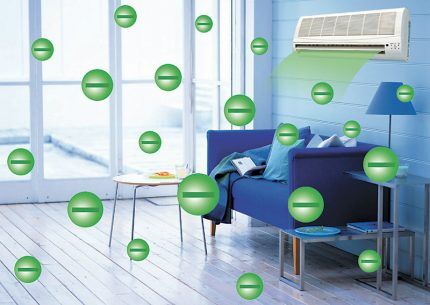
Due to this, the total amount of flux rushing towards positively charged ions increases. Streams of particles of opposite charges cause an electrical discharge in the air. As a result, the formation of plus and minus oxygen ions occurs continuously.
The air mass ionized with the help of a blower is distributed throughout the room. There are design options for ionizers, built-in and separate.
Whether it is useful to carry out the process of ionization of air in an apartment or, conversely, harmful, we will try to figure it out.
Benefits of air ionization
When a person experiences a lack of air ions, the body begins to overproduce hormones such as histamine and serotonin.
An excessive amount of them provokes oxygen starvation of cells due to disruption of the lungs. This can result in headaches, increased fatigue, asthma attacks, depression and anxiety.
Having been in a room where the air is saturated with negative ions, there is no doubt about the usefulness of ionization.Although medicine does not give clear advice on this matter, a similar method is often used in clinics.
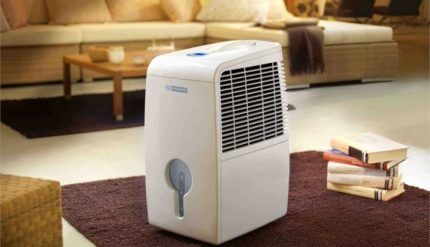
The effectiveness of ionized air is due to the fact that when filled with air ions, it stimulates red blood cells and they begin to work more actively. At the same time, gas exchange in the lungs increases by 10%.
Due to this, the following positive processes are observed:
- The quality of sleep improves, which means that rest becomes complete.
- Performance indicators increase.
- Immunity grows, well-being improves.
- The psychological state returns to normal. This is valuable in the treatment of neuroses and depression.
- The metabolic rate increases, and this alleviates the symptoms of diseases and reduces the duration of their course.
- Appearance changes for the better.
- The negative impact of radiation from household electrical appliances is reduced.
In addition to all of the above, many observe that ions have a beneficial effect on skin receptors, while reducing pain sensitivity.
Judging by the reviews, it can be noted that if you have such ailments as acne, psoriasis and similar diseases, you can improve your condition by using this device.
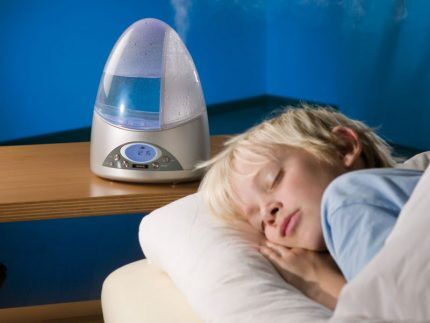
The ionizer will benefit office workers who spend more than two hours in front of a computer monitor.For those who are forced to stay in a confined space for a long time, the ionizer will also be useful.
The main disadvantages of using the device
Ionization has one unpleasant property - the charge is transferred to all particles present in the air. This means that both dust and microorganisms that are in the air of the room are charged.
They begin to be attracted to various surfaces. As a result, a dust deposit forms around the ionizer and on the furniture. If wet cleaning is done infrequently, it will all become airborne again.
If this charged dust enters the lungs, it can cause dangerous illnesses. Conclusion - ionization is dangerous in contaminated rooms. There are countries where the sale of ionizers is prohibited.
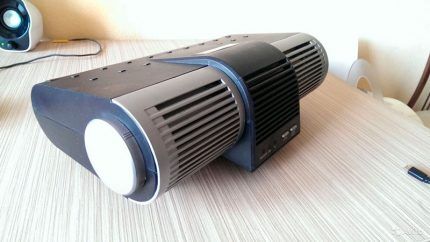
The electrostatic background created indoors by negative air ions is also harmful. Under its influence, its charge is transferred both to synthetic things and to the person himself. Ionization cannot be carried out when there are people in the room.
The next harmful factor is ozone. It is a product accompanying ionization. Its presence is evidenced by the smell of post-storm freshness.
Despite the pleasant smell, ozone is a strong oxidizing agent, which is harmful to the body. Feeling its presence, the room needs to be ventilated urgently.
How to reduce the negative moments of ionization?
The main danger of the procedure lies in the composition of ionized air. It is not entirely natural for human lungs.Large numbers of charged particles can be harmful to the respiratory tract.
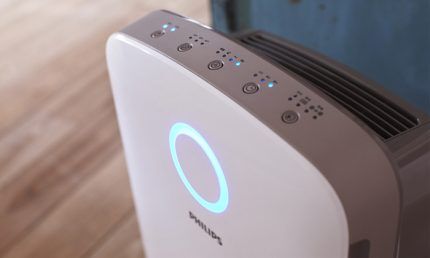
Many manufacturers supplement their devices with ultraviolet lamps. This is good, on the one hand, since ultraviolet radiation destroys microbes. On the other hand, at high radiation levels, the lamp produces ozone. This lamp is quite often purchased for home use. We talked about the features of its application and the intricacies of choosing a UV lamp in this material.
So, if the ionizer is equipped with a powerful UV lamp, it is better not to use it. When there are people in the house who are very sensitive to ozone, the air should not be ionized either.
Type #2 - bipolar ionizer
Manufacturers claim that air enriched with a bipolar device does not have the inherent disadvantages of using a unipolar device.
Natural air masses contain both positive and negative ions. Unipolar ionization does not exist here. There are 20% more positive air ions.
A bipolar ionizer is capable of completely simulating a natural process. In this case, ions can be supplied into the air in portions, independently setting the concentration. In addition, air ionized in this way helps prevent magnetization of objects.
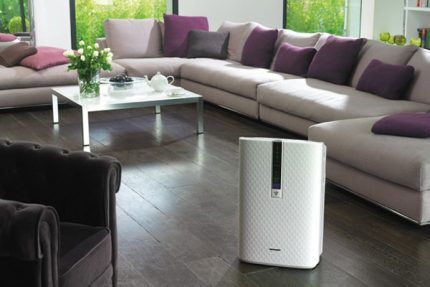
This method of ionization also has disadvantages.The bipolar ionizer is structurally designed in such a way that negative and positive ions are not produced simultaneously, but alternately, in portions.
Their clusters are something like clouds. One contains only negative ions, the other contains exclusively positive ions. In nature they are constantly moving and mixing, but in a closed space this is not the case.
The device has a fan, and useful particles are distributed along the length of its air stream. For this reason, they are concentrated mainly only in the area of the ionizer.
Bipolar ionization is better than monopolar, but provided that there is good air circulation in the room. To do this, you need to properly organize the influx, for example using supply valve to the wall or valves for windows, and adjust the operation of the hood. Then natural stirring will help establish the ionic balance.
Soft ionization using a salt lamp
When the internal space is ionized with a salt lamp, negative ions are also released, and under the influence of humidity they spread throughout the room.
This lamp can be kept on constantly. In this case, uniform, continuous and soft ionization occurs.

This ionization method is recommended for use in respiratory diseases, allergies, diabetes, and rheumatism. It also promotes psychological relief.
The only condition is that ionization cannot be carried out in the bathroom or other places where there is access to water.Otherwise, excess moisture will cause the lamp to simply fall apart.
A salt lamp weighing 3 kg can carry out effective ionization in a room with a maximum area of 12 m². If the room is larger, you need a large ionizer or a chandelier consisting of a certain number of salt lamps.
Carrying out air enrichment using this method has no contraindications. Although there are cases of individual intolerance, they are very rare. Still, you need to get used to it gradually, carefully monitoring the body’s reaction.
Features of ionization in a car
Air masses enter inside the car not only from the outside. The driver mainly breathes what is inside the cabin. There is a mixture of fumes from upholstery, cigarette smoke, trim, perfume, and sometimes even carbon monoxide.
Those who spend a lot of time on the road suffer from fatigue and headaches. All this is due to a lack of negative anions. Moreover, the products of incomplete combustion of carbon can cause poisoning.
Periodically opening windows will not help in this case, so the air in the car interior should also be ionized. For this purpose, a small-sized device has been developed - a specially designed ionizer.
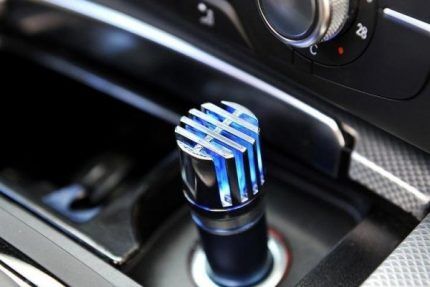
If there is a person suffering from ARVI in the cabin next to the driver, ionization is inappropriate and it is better to turn off the ionizer. The reason is the faster spread of infection in a confined space.
Good advice for buyers
The main rule is not to use the ionizer around the clock.Manufacturers in the instructions for each of their models indicate the period during which it should work.
Recommendations for choosing a device
It is extremely important that power the device corresponded area premises. High power in a small area will lead to oversaturation of the air with ozone molecules, and this is harmful to the body.
But from a weak device you may not feel the expected effect.
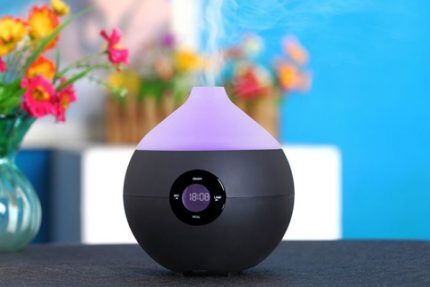
Also, when choosing, you should pay attention to manufacturer — well-known and reliable brands offer devices of decent quality and provide a guarantee for their products. We have listed the best offers of ionizers on the market in next article.
Features of care and operation
The location where the device is installed is also of great importance. There are manufacturer recommendations in this regard and they must be followed.
The instructions stipulate the optimal distance from vertical enclosing structures and other electrical equipment. Subject to these conditions of use, ionization will be both as effective and safe as possible.
Such an aspect as caring for a device that enriches the atmosphere in the house with useful ions is just as important as the previous conditions. In order for the air to be truly clean and healthy for those living in the house, the device must be cleaned regularly.
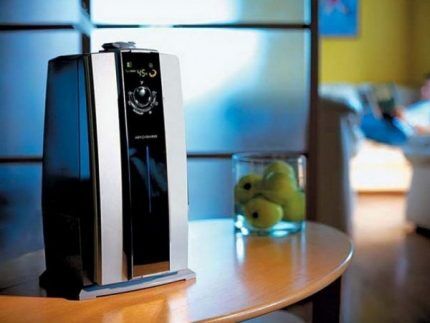
Ionization does not cancel ventilation at all. Quite the contrary - before turning on the ionizer, the apartment must be ventilated - open the windows or, alternatively, use air conditioner with supply fresh air.
Ionization should absolutely not be used for cancer patients. Since the produced particles enhance metabolism, tissue nutrition improves, including malignant cells.
Elevated temperature also causes the impossibility of air ionization. The reason is the same - increased metabolism will further raise the temperature.
Conclusions and useful video on the topic
Demonstration of the air ionization process:
Ionization and ionizer for car:
Some experts talk about an overdose of ions in the body. Others believe that this statement is erroneous. The argument is that oxygen is transported to cells by hemoglobin molecules, and they are capable of accepting a certain number of ions. The body removes excess particles outside, so they do not cause harm.
Of course, it is necessary to ionize the air, but it is important to know and remember the contraindications. In any case, by following the recommendations, you can breathe tasty and fresh air in your home, like after a thunderstorm..
Do you use a household ionizer at home? Share your impressions of its use, tell us if you are satisfied with this model? Add a photo of your ionizer below under this publication, write recommendations for beginners on the care and operation of the device.
If you have any questions about choosing an ionizer, please ask our experts in the comments block below.




We never used ionizing devices, but when we moved to a new apartment we encountered a problem: it was impossible to breathe in the apartment, the nasal mucous membranes dried out, and for children this resulted in constant ARVI, well, a general headache and poor sleep.
The ionizer helps, attracts dust, that's for sure. But we do wet cleaning often, so this cannot be called a problem. If you follow all the recommendations that are noted in the instructions for use of the device, you can solve many problems. But you also need to take into account that the air quality in the room depends on the materials with which the walls and ceiling are finished, and, of course, it is necessary to ventilate.
My husband and I started thinking about air ionization when we had a child. And my husband himself was an asthmatic in the past, now there are no attacks, but of course it’s better to play it safe, especially since the air ionizer is not so expensive that you need to save on it. But after reading reviews about it, I decided not to buy it, because I don’t have the opportunity to remove dust 2 times a day, and if it sits and charges, it will be very harmful. An ambiguous device. It's better to buy a humidifier.
That's right, or better yet, a humidifier (ideally with heated water) and a built-in ionizer function...
How can electrons be POSITIVELY charged?! They are negative!
I also have an old Russian device (“Super+”) - but the instructions say that it should work constantly, even while sleeping in this room...
Yes, stupidity, of course :) This is a typo. This meant positively charged ions.
Regarding the fact that the ionizer and humidifier should always work - these are truisms.After all, a person spends a third of his life sleeping, and it would be stupid to breathe at this time air that is not the same as during daytime activity. However, if you are a light sleeper, then you need to choose a model with the lowest noise level.
In general, I am very glad that there are good domestic manufacturers of air ionizers, but they need to work on the design of the housing.